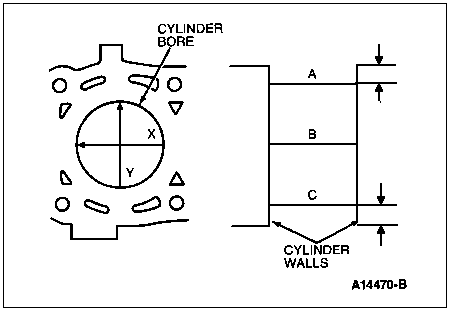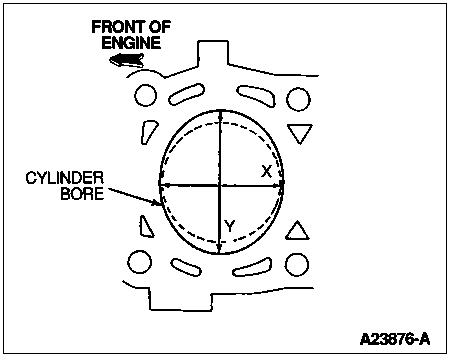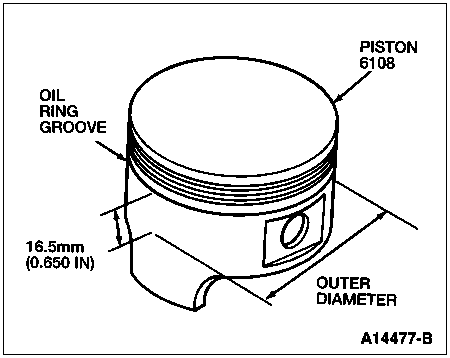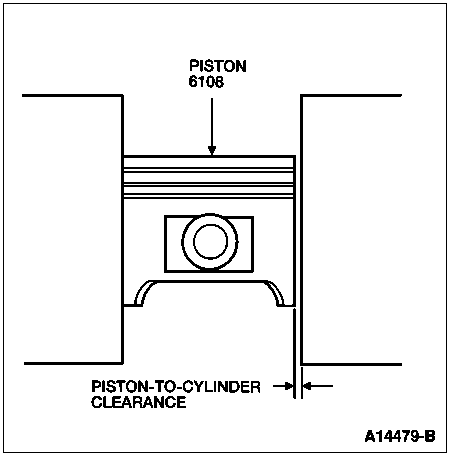
Section 03-00: Engine, Service | 1996 All F-150, F-250, F-350, F-Super Duty and Bronco Vehicles Equipped with 4.9L, 5.0L, 5.8L or 7.5L Gasoline Engines, and 7.3L Diesel Engines Workshop Manual |
Cleaning
If the entire engine (6007) has NOT been disassembled, clean the individual cylinder bore(s) with a cloth soaked with solvent. Dry with a clean, lint-free cloth.
If the entire engine HAS been disassembled, refer to Cylinder Block in the Cleaning and Inspection portion of this section.
After any cylinder bore service operation, such as honing or deglazing, clean the bore(s) with soap or detergent and water. Then thoroughly rinse the bore(s) with clean water to remove the soap or detergent, and wipe the bore(s) dry with a clean lint-free cloth. Finally wipe the bore(s) with a clean cloth dipped in XO-10W30-QSP or equivalent motor oil meeting Ford specification ESE-M2C153-E.
Inspection
Before removing the piston:
Check the amount of ridge at the top of the bore. A thick ridge is a sign of considerable wear.
Look for signs of coolant in the bore, especially rust on the bore surface indicating possible leaking head gasket or a crack in the cylinder bore.
Check the top of the piston for possible oversize. If oversize pistons have been installed, the oversize will be stamped in the top of the piston.
After the piston is removed and the bore cleaned:
Look for scoring. These are parallel gouges usually on the piston thrust side, that is, at right angles to the piston pin. If scored, the cylinder will have to be refinished.
Look for cracks. If unsure about a crack, tiny cracks may be detected by coating the bore with a mixture of 25 percent kerosene and 75 percent light engine oil. Wipe the bore dry and immediately apply a coating of zinc oxide dissolved in wood alcohol. Do not use rubbing alcohol as a substitute. If cracks are present, the coating will become discolored at the damaged area. Replace the cylinder block if it is cracked. Magnafluxing may also be used.
Check for cylinder wall glazing. When refinished, the cylinder bore is given a slightly rough finish with a cylinder hone to help seat the new piston rings. This finish is worn away as the rings and cylinder bore mate and the bore becomes glassy smooth. If the engine has been run enough for this to have happened, the cylinder will at least have to be honed to seat the new rings on the piston. New rings should be installed when the piston is removed and reinstalled because piston rings are manufactured with a special finish by the factory to help them wear-in and seat. In seating, the special finish is worn off. Reusing piston rings will result in high oil consumption.
Cylinder Bore
Make sure cylinder bore is clean and dry before measuring.
Using a suitable cylinder bore micrometer, measure the cylinder bore(s) in the X and Y directions (90 degrees apart) at points A, B, and C. The X direction is parallel to the piston pin. The Y direction is perpendicular to the piston pin and is the direction of piston thrust.

Cylinder Bore Taper
Subtract the micrometer reading from point C direction Y from point A direction Y. Also from point C direction X from point A direction X. Each difference should be less than 0.127mm (0.005 inch). If taper exceeds this specification, cylinder will have to be refinished.

Cylinder Out-of-Round
Subtract the reading in direction X (non-thrust) from direction Y (thrust side) at all points A, B, and C. All readings should be less than 0.127mm (0.005 inch). If out-of-round exceeds this specification, cylinder will have to be refinished.

Cylinder Bore Diameter
Measure the diameter of the piston on the thrust side — at right angles to the piston pin — 16.5mm (0.650 inch) below the oil ring groove.

Measure the cylinder bore diameter at right angles to the piston pin at points A, B, and C as described under Cylinder Bore Taper.
Subtract the piston diameter from the cylinder bore diameters. The difference should not exceed the maximum clearance allowed in the specifications in the appropriate Section 03-01A (4.9L SFI), Section 03-01B (5.0L and 5.8L MFI), Section 03-01C (7.5L MFI) or Section 03-01D (7.3L diesel).

Cylinder Reboring
Reinstall main bearing caps and tighten to specifications listed in the appropriate Section 03-01A (4.9L SFI), Section 03-01B (5.0L and 5.8L MFI), 03-01C (7.5L MFI) or Section 03-01D (7.3L diesel).
Refinish cylinder to a standard oversize following the tool manufacturer's instructions. Allow for honing and piston fitting.
Cylinder Wall Honing
Hone the cylinder bore either:
Measure the diameter of the piston on the thrust side — at right angles to the piston pin — 16.5mm (0.650 inch) below the oil ring groove.
Measure the cylinder bore diameter at right angles to the piston pin at points A, B, and C as described under Cylinder Bore Taper.
Subtract the piston diameter from the maximum cylinder bore diameter to determine the maximum amount of material that can be removed.
Hone the cylinder according to the hone manufacturer's instructions to obtain the proper bore surface finish of 18-38 rms.